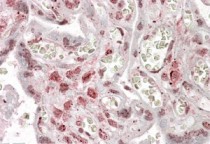ARG65071
anti-MLX antibody
anti-MLX antibody for IHC-Formalin-fixed paraffin-embedded sections and Human
Cancer antibody; Gene Regulation antibody; Metabolism antibody
Overview
| Product Description | Goat Polyclonal antibody recognizes MLX |
|---|---|
| Tested Reactivity | Hu |
| Predict Reactivity | Ms, Rat, Cow, Dog |
| Tested Application | IHC-P |
| Specificity | This antibody is expected to recognize all three reported isoforms (NP_937848.1; NP_937847.1; NP_733752.1). |
| Host | Goat |
| Clonality | Polyclonal |
| Isotype | IgG |
| Target Name | MLX |
| Antigen Species | Human |
| Immunogen | C-QIVKAHQDNPHEGED |
| Conjugation | Un-conjugated |
| Alternate Names | Max-like bHLHZip protein; Protein BigMax; Class D basic helix-loop-helix protein 13; TCFL4; Transcription factor-like protein 4; Max-like protein X; MAD7; MXD7; bHLHd13 |
Application Instructions
| Application Suggestion |
|
||||
|---|---|---|---|---|---|
| Application Note | IHC-P: Antigen Retrieval: Steam tissue section in Citrate buffer (pH 6.0). * The dilutions indicate recommended starting dilutions and the optimal dilutions or concentrations should be determined by the scientist. |
Properties
| Form | Liquid |
|---|---|
| Purification | Purified from goat serum by antigen affinity chromatography. |
| Buffer | Tris saline (pH 7.3), 0.02% Sodium azide and 0.5% BSA. |
| Preservative | 0.02% Sodium azide |
| Stabilizer | 0.5% BSA |
| Concentration | 0.5 mg/ml |
| Storage Instruction | For continuous use, store undiluted antibody at 2-8°C for up to a week. For long-term storage, aliquot and store at -20°C or below. Storage in frost free freezers is not recommended. Avoid repeated freeze/thaw cycles. Suggest spin the vial prior to opening. The antibody solution should be gently mixed before use. |
| Note | For laboratory research only, not for drug, diagnostic or other use. |
Bioinformation
| Database Links | |
|---|---|
| Background | The product of this gene belongs to the family of basic helix-loop-helix leucine zipper (bHLH-Zip) transcription factors. These factors form heterodimers with Mad proteins and play a role in proliferation, determination and differentiation. This gene product may act to diversify Mad family function by its restricted association with a subset of the Mad family of transcriptional repressors, namely, Mad1 and Mad4. Alternatively spliced transcript variants encoding different isoforms have been identified for this gene. [provided by RefSeq, Jul 2008] |
| Research Area | Cancer antibody; Gene Regulation antibody; Metabolism antibody |
| Calculated MW | 33 kDa |
Images (1) Click the Picture to Zoom In






